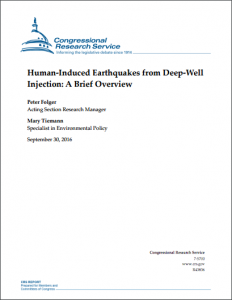Full Title: Human-Induced Earthquakes from Deep-Well Injection: A Brief Overview
Author(s): Peter Folger & Mary Tiemann
Publisher(s): Congressional Research Service
Publication Date: September 1, 2016
Full Text: Download Resource
Description (excerpt):
The development of unconventional oil and natural gas resources using horizontal drilling and hydraulic fracturing has created new demand for disposal wells that inject waste fluids into deep geologic formations. Deep-well injection has long been the environmentally preferred method for managing produced brine and other wastewater associated with oil and gas production. However, an increasing concern in the United States is that injection of these fluids may be responsible for increasing rates of seismic activity. The number of earthquakes of magnitude 3.0 or greater in the central and eastern United States, where there are many injection wells, has increased dramatically since about 2009. For example, over 60 earthquakes of magnitudes 4.0 to 4.8 have occurred in central Oklahoma from 2009 to mid-year 2016. Some of these earthquakes may be felt at the surface. The largest earthquake in Oklahoma history (magnitude 5.8) occurred on September 3, 2016, near Pawnee, causing damage to several structures. Central and northern Oklahoma were seismically active regions before the recent increase in the volume of waste fluid injection. However, the sharp uptick in earthquake activity does not seem to be due to typical, random changes in the rate of seismicity, according to several studies
